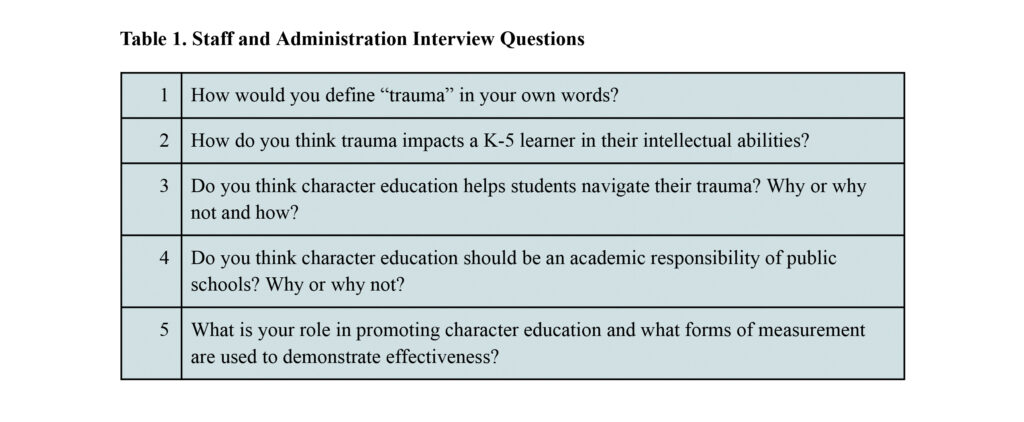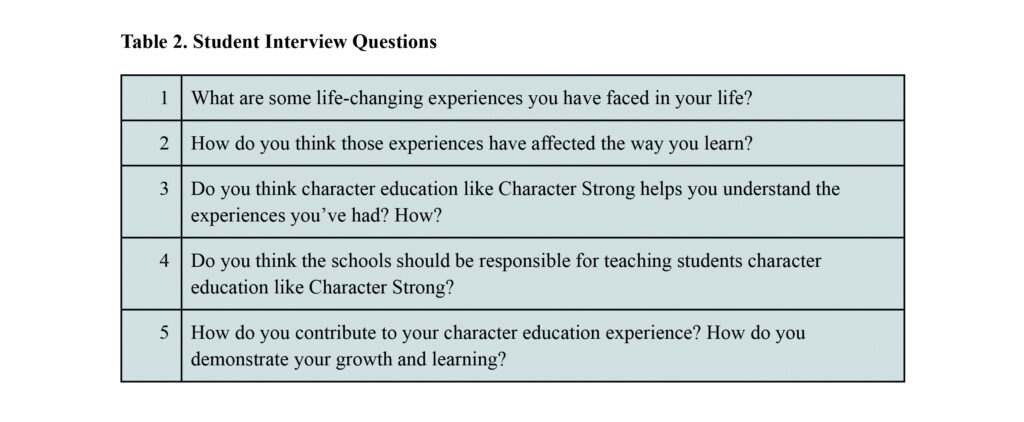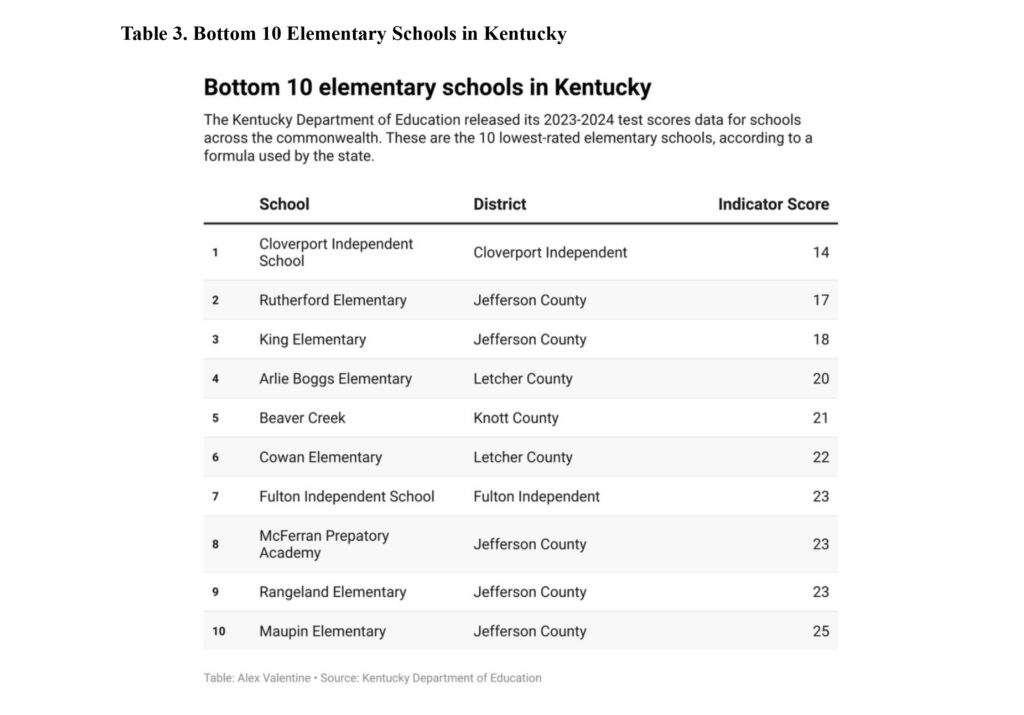Rooted in Research
Character Education initiatives by Empowered Educators, Inc. equips students with the mindset of tools needed to address their socio-emotional needs in a systematic approach. All of our programs and curriculum are rooted from factual, quantitative and qualitative outcomes. As a collective, educators, families, and students, assess cohesively to ensure interconnectedness of our programs, our teaching, and our conferencing are promoting student academic success and positive behavioral outcomes.
The Benefits of Character Education in Summer Enrichment
Character, or a lack thereof, influences decision making, and thus, is observable in conduct (Mischel and Wallace, 2015). A review of effective and ineffective strategies in promoting character development tells us the community and the relationships that form it best aid prosocial character formation, rather than approaches that stress lecturing and moralizing (Journal of Extension, 1998). Study participants who attended a summer camp were significantly more likely to state an interest in social entrepreneurship than those who had not attended. Why? They cited the influence of counselors, especially in mentoring them to develop social and leadership skills (Mischel and Wallace, 2015).
At home, at camp, at school, and beyond, influential teachers and programs motivate young people to:
- Own assigned responsibilities
- Engage in dialogue about values
- Embody positive traits of character
- Develop trusting relationships with mentors in their lives
- Receive encouragement about their growth and ability to succeed
Journal of Extension. (1998). Character education: developing effective programs. Retrieved from www.joe.org/joe/1998april/a3.php
Mischel, L., & Gray Wallace, S. (2015, January 1). A consequence of character: How Summer camp promotes character, leadership, and entrepreneurship. American Camp Association.
https://www.acacamps.org/article/camping-magazine/consequence-character-how-summer-camp-promotes-character-leadership-entrepreneurship

The Benefits of Character Education in Academics
A meta-analysis was conducted on 52 studies which examined the associations between the explicit teaching, or implementation, of character education with a host of academic (i.e. school achievement) and positive behavioural (e.g. self-discipline or reduced disruptive behaviour) outcomes (Jeynes, 2017). Earl et al. (2017) revealed that character education had a positive overall association when both academic and behavioural outcomes were combined.
Earl, S., Arthur, J., & The Jubilee Centre for Character and Virtues. (2017). Character and academic attainment: Does character education matter? In Insight Series.
https://www.jubileecentre.ac.uk/wp-content/uploads/2023/07/Insight_Briefing_Paper_JA_SE.pdf
Jeynes, W. H. (2017). A meta-analysis on the relationship between character education and student achievement and behavioral outcomes. Education and Urban Society. 49(1), 1-39
The benefits of Character Education in Conduct
Character education taught with fidelity in a school atmosphere generates the appropriate responses to address common issues we as people endure; however, with the reinforcement of character education concepts revisited through nonprofit enrichment, the ideas that were once learned in school, now become applied, by the learner, to the context of life; Thus remedying and healing the whole child, year round. It is imperative for not only teachers, but the entire school community to carry out the practices and framework of building character within our youth (Elias, 2009). In a study that included three suburban elementary schools in Cherry Hill, New Jersey, Ferrara found that all three schools decreased in filed discipline reports and increased in positive behaviors from the execution of character education programs.
Elias, M. J. (2009). Social-Emotional and Character Development and Academics as a Dual Focus on Educational Policy. Educational Policy, 831-846.
Ferrara, Katie M., “The effectiveness of character education on student behavior” (2019). Theses and Dissertations. 2702. https://rdw.rowan.edu/etd/2702
Supported Articles/Essays:

No More Trauma:
A Case Study about Character Education and the Effects of School-Aged Children
I. Introduction
Student discipline has become one the most recent topics on the frontlines of education for some time now. Reports across the U.S. highlight growing concerns about the prevalence of school threats, violence and concurrent patterns of aggressive behavior among students and their peers. Between witnessing fights streaming through online social media platforms, bomb threat calls, students carrying weapons to school, and the loss of innocent lives due to school shootings, bullying and cyber-bullying, it is fair to reason that safety is one of the top priorities in public education today. But many wonder how do school districts keep students safe when students are often the caveat to the heightened incidence of behavior infractions?
Reporters, and journalists, amongst many, have cited the COVID-19 pandemic as one of the major contributing factors to the rise of disciplinary issues – in comparison to previous years before the global outbreak. Others identify the cause for the increase of student misbehavior to factors such as inequities in home life, increased levels of stress, anxiety and other symptoms of untreated medical conditions, students lack of prerequisite knowledge and skills, as well as other identifiable factors. The purpose of this case study is to address the underlying cause of student discipline – a trait commonly misunderstood and unequivocally not seen – psychological trauma and how systematic implementation of curriculum such as character education can remedy mainstream behavior misconduct that has plagued public school safety and education today.
II. Context
Milburn T. Maupin Elementary is an Accelerated Improvement School (AIS) located in the Parkland community of the Jefferson County Public School district in Louisville, Kentucky.
Stationed in the heart of the Westend, it is a school is historically known for being named after the former acting Superintendent, Milburn Taylor Maupin (1926 – 1990) , the first African American appointed as a central office administrator of the Louisville School System in 1965 and the first President of the Louisville Education Association in 1968. Although a school acknowledged for its groundbreaking and decorated history, it is an academic institution that has undergone radical changes in the recent decade that has rippled effect throughout the body of its attracting students, families, teachers, and administrators. In 2014, the Jefferson County Board of Education announced the approval for a School of Innovation to open for the 2015-2016 school year at Maupin Elementary. The purpose was to cultivate a “Waldorf-inspired arts academy” that nurtured the idea of student “innovation.” However, by the end of the 2017 school year, less than two years after its implementation, the Jefferson County Board of Education unanimously voted to remove the magnet from the struggling Maupin Elementary School (Courier-Journal, 2017).
Reasons ranging for the lack of the training and commitment to its model, poor implementation by district leadership, the absence of student diversity, and occurrences of disruptive student behavior. But even with the transition of a traditional approach to teaching and learning, test scores continued to spiral and concerns about student safety and behavior became the focus for equity, instruction, and inclusion.
Maupin Elementary entered ‘priority’ status in 2018, as it struggled to meet its improvement goals by its third consecutive year. Filled with students who face extreme barriers incomparable to their nonmarginalized counterparts, student misbehavior and conduct continued to overthrow the instructional focus and learning outcomes as measured by the Kentucky Summative Assessment (KSA) and Comprehensive School Survey(CSS). It was apparent that something deeper was needed to be identified and addressed with the underrepresented population of students.
In 2023, 392 students were enrolled at Maupin Elementary; 345 of those students were black and 362 were reported economically disadvantaged. Research shows that students from economically disadvantaged backgrounds often face a range of challenges including, but not limited to, under-resourced schools such as lack of experienced teachers, limited access to meet basic needs like food, shelter, and healthcare, potential developmental delays and/or underlying health conditions, and higher rates of behavioral problems. To address the identified needs of the student population, the school implemented the Multi-Tiered Systems of Supports (MTSS) that helps educators apply academic and behavioral support strategies for students with disabilities and various outstanding needs. One of those systems being a social/emotional program and curriculum for teaching such skills known as PATHS Program LLC and CharacterStrong. Since its implementation dating back to 2017, morale in student conduct has significantly shifted as well as an increase of student achievement in test scores. Teachers also supplement additional learning topics not covered with research-based and evidence-based programs such as Drop the Drama and Student Self-Care Kits.
III. Review of Literature
Maupin Elementary became “Trauma-Informed” with its changeover from its innovative programming to reestablishing the Kentucky Academic Standards (KAS) as the required standards that all Kentucky students should have the opportunity to learn before graduating from Kentucky high schools (Kentucky Department of Education, 2023). Complex trauma in children can affect them in a multitude of ways. Children whose families and homes do not provide consistent safety, comfort, and protection may develop ways of coping that allow them to survive and function day to day (Peterson, 2018). Survival instincts and learned adaptations from a child who has experienced one or more frequent events of psychological trauma can vary and look like behaviors that can commonly be misunderstood for defiance, rejection, and student misbehavior. All actions that people who have not experienced trauma may misinterpret for disruptive behavior. Peterson (2018) notes that emotional responses are often one of the many trauma responses a student might experience and cling to in the learning space. Children who have experienced complex trauma often internalize and/or externalize stress reactions and may experience significant depression, anxiety, or anger; as a result, their emotional responses may be unpredictable or explosive (Peterson, 2018). It’s important to note while Peterson may emphasize the importance of trauma being complex, many would argue that trauma is trauma – no matter how complex or indirect one may see and a child can be the most vulnerable in a space where a reminder of a traumatic event occurs, oftentimes that being in the presence of teachers and their peers. Trauma-informed schools are safer, more successful, and support stronger community – crisis prevention training can play an important role (How Trauma-Informed Schools Help Every Student Succeed | Crisis Prevention Institute (CPI), n.d.).
Psychological Trauma also has effects on child development and the brain. Research has shown that students who have endured at least 1 traumatic experience throughout their lifetime encounter problems with the functioning of their prefrontal cortex (PFC). The PFC is the part of the brain that controls executive functions such as decision-making, problem-solving, and thinking. This part of the brain also regulates the emotions, actions, and reactions to stimuli in a person’s environment. Furthermore, Peterson (2018) reports that stress in an environment can impair the development of the brain and nervous system. An absence of mental stimulation in neglectful environments may limit the brain from developing to its full potential (Peterson, 2018). Mental stimulation improves cognitive function such as thinking and reasoning skills, nurtures the ideas of innovation and creativity, and more importantly, reduces levels of stress. Children who experience trauma or have a trauma history may develop chronic or recurrent physical complaints, such as headaches or stomachaches (Peterson, 2018). These symptoms often distract student motivation from learning and engagement. Sometimes it can propel student impulse and reactions to overstimulation.
With regard to character education, a meta analysis of 52 studies was conducted by Jeynes (2017) to examine the relationship between character education and student achievement and behavioral outcomes. Results indicated that character education was associated with higher levels of educational outcomes, including grades and test scores. The delivery of character education programming was also associated with increased self-discipline (Jeynes, 2017).
IV. Methodology
In this study, 5 representatives of Maupin Elementary School that occupied positions of teaching, administration, and students attending the school were interviewed and asked a range of questions about their thoughts or personal experiences with trauma and how character education has contributed to the behavioral outcomes of the student body and student academic achievement. The adult participants involved in the interview process possess over 15 plus years of experience in Special Education, School Administration and Leadership, and Teaching. The students who were interviewed have attended Maupin Elementary since its readaptation to the KAS in 2017 and have been taught at Maupin since grade levels K – 3.


V. Findings
Question #1 of the interview asks for participants to share their definition of trauma. A collective agreement between students and staff define trauma as negative life experiences people are exposed to that impact them on an ongoing basis and can look differently from person to person. Trauma creates an environment of at-risk behavior for children. An example of a traumatic experience that Student A had endured in their life was the sudden passing of their infant sibling. The student expressed how their grief resulted in dissociation and withdrawal, but with the suggested topics and teaching of character education programs like CharacterStrong and Drop the Drama, the student felt motivated to navigate through their trauma, persevere and to channel their grief through their intellectual giftedness. The student was identified as a learner in the Primary Talent Pool in August 2024, just months after his family’s tragic loss.
The student also expressed how he has learned to internalize ethical character traits such as having a growth mindset, grounding himself with “5-Finger Breathing” whenever he feels discomfort, and picking/choosing his battles wisely. He quotes, “schools should be responsible for teaching character education because it helps students think before they act.” Staff and administrators agree that character education should be responsible for teaching students the ethics and essentials to life.
Although character education has made a great impact on student learning, teachers and staff believe it has the most potential to influence students when it is taught in conjunction with MTSS and with fidelity. In other words, character education does not thrive as a subject in isolation of others and inconsistencies in teaching can lead to inconsistency in behavior. Students with moderate-to-severe levels of behavior needs should also be identified for more intensive support that may require one-on-one therapy or even small group guidance/counseling.
As a result of Maupin’s efforts to provide wraparound services for their students, 2023- 24 KSA test scores showed 7% Proficient in reading, 1% Distinguished in Reading, and 5% Proficient in Math. Maupin’s ranking in the state rapidly projected from being the bottom #1 to #10. Overall, the school is headed on an upward trajectory.

VI. Conclusions
Teaching with trauma in mind sounds a bit easier said than done, so how does character education remedy some of the faults demonstrated in student discipline? Based on the literature review, analysis of KSA data, and findings from the interviews, it is clear that character education does rectify common behavior needs in school-aged children who have experienced trauma. When taught and reinforced with integrity and fidelity, it can increase academic performance and student self-esteem. Some of the best tools that can be used to monitor implementation of its process is through classroom observations and walkthroughs to ensure it is occurring, analysis of data of staff, student and parent surveys (i.e. Comprehensive School Survey), as well as disciplinary data.
References
Courier-Journal, A. R. (2017, April 26). JCPS board nixes School of Innovation at Maupin. The Courier-Journal.
https://www.courier-journal.com/story/news/education/2017/04/25/jcps-board-decide-fate-school-innovation/100860078/
How Trauma-Informed Schools Help Every Student succeed | Crisis Prevention Institute (CPI). (n.d.). Crisis Prevention Institute (CPI). https://www.crisisprevention.com/blog/education/how-trauma-informed-schools-help-eve ry-student-succeed/
Gorla, L., & Honeycutt Spears, V. (2024, October). Here are highest, lowest rated schools across Kentucky based on 2022-2023 test data. Lexington Herald Leader. https://www.kentucky.com/news/local/education/article281269038.html
Jeynes, W. H. (2017). A Meta-Analysis on the relationship between character education and student achievement and behavioral outcomes. Education and Urban Society, 51(1), 33–71. https://doi.org/10.1177/0013124517747681
Kentucky Department of Education. (2023, September 15). Kentucky Academic Standards. https://www.education.ky.gov/curriculum/standards/kyacadstand/Pages/default.aspx
Peterson, S. (2018, June 11). Effects. The National Child Traumatic Stress Network. https://www.nctsn.org/what-is-child-trauma/trauma-types/complex-trauma/effects
